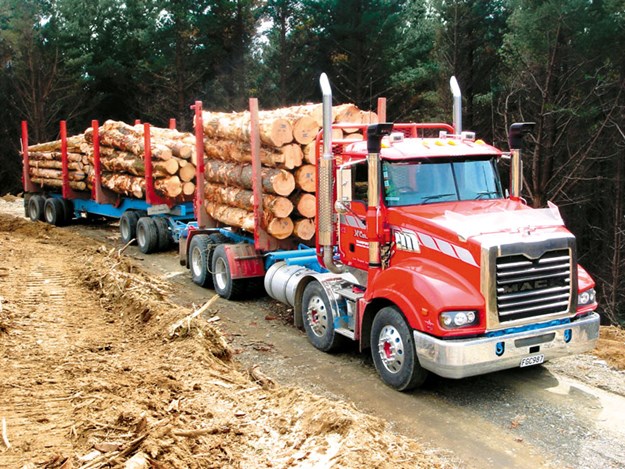Comment: Log truck gradeability
A review of log truck gradeability in NZ

Forest road design in steep terrain often requires a balance between optimal design for transport, environmental impact, resilience, and whole-of-life road cost. Generally, for forest access in steep terrain, the higher the allowable road grade, the shorter the road network required, resulting in less driving distance and lower construction costs.
However, if a forest road is too steep, it becomes a risk in terms of all-weather access, safety, truck operating costs, truck type, and in general reduces gradeability. Gradeability is a truck performance measure and can be defined as the maximum grade (slope of the road) a vehicle can negotiate at a given steady speed.
Road grade is one of a number of important design factors and will vary with road standard, which refers to the intended use of that road. For forestry applications, a road standard is dictated by the intended truck configuration together with the intensity and duration of road use.
Road grades become more important in steeper terrain; there’s a need to balance road construction and transportation costs. A cost-benefit analysis can be completed to ascertain if there’s a financial benefit in constructing a longer road at a lower grade, for the design life of the road.
This is referred to as an ‘optimal grade’ that balances road cost and risk with transport efficiency. Road grade limits can be defined for different reasons, including safety, but also for environmental performance. Technically, truck movement on a grade will be limited by the traction it can develop between the tyres and the road surface and the torque that can be applied to the tyre.
The power of the truck will then dictate the speed. The NZ Forest Road Engineering Manual (FREM) sets out some grade ranges for the different road standards that are defined in the manual.
For arterial roads, this is eight to 10%, for secondary roads, this is 10 to 12%, and for spur roads, it’s 12 to 14%. In the 2020 edition of the FREM, there’s a new reference to have an absolute upper limit of 12.5% for larger vehicles (specifically 50MAX and/or High Productivity Motor Vehicles).
Because few New Zealand forest roads provide for through traffic opportunities, we tend to differentiate between ‘favourable’ and ‘adverse’ road grades. Favourable refers to roads heading into the forest uphill when you would expect the truck to be unloaded, and hence be able to cope with higher road grades.
While an adverse grade is the most common reference point, a vital factor for safety is the ability to stop while travelling on a favourable grade (laden, downhill). While controlled stopping on most roads is a function of effective braking and adequate traction, it’s also a question of adequate stopping distance.
For safety, the NZ Approved Code of Practice for Safety & Health in A Review of Log Truck Gradeability and Unsealed Forest Road Grade 2 Forest Operations (ACoP) specifically states that a 20% grade is the maximum for log transport in New Zealand. This is a very high value and is only substantiated in the literature for more extreme situations.
The new Italian forest road rules specifically allow for roads up to 20% for trucks up to 44 tonnes or 22% for trucks limited to 26 tonnes. Within the scope of this project, a basic model was also built on engineering principles to investigate the effect of a range of static and kinetic friction values on the common truck dimensions.
The outputs of this model are correlated to the friction values that were sourced from a range of literature. A slope grade limit of 10% for maintaining traction was identified based on the limiting friction factor of 0.1, aligning with that of extreme cases where operating on mud, packed snow, or ice.
This report focuses on forest road grade and gradeability for log trucks on unsealed roads. It recognises that most of the values presented are for straight sections of the road. Factors such as road curves effectively reduce the recommended grade values because the curve itself changes the dynamics between the truck and the road (creates an uneven distribution of load through the tyres).
This effect is quite extreme where traversing switchbacks, but it does depend largely on the truck type, but not the total mass. It’s the authors’ opinion that for larger mass vehicles (length 24 metres and up to 60 tonnes) under New Zealand conditions, a desirable maximum grade for larger dimensioned, or larger mass logging vehicles, the current recommended FREM reference value of 10% for maximum desirable grade on secondary roads is suitable—up to 12.5% for an exceptional circumstance such as short segments. For favourable roads, there are plenty of guides that successfully argue for slightly higher grade—up to 15%.
LTSC engaged Prof. Rien Visser and Campbell Harvey NZ School of Forestry, University of Canterbury to scope out this report. For a copy of the full report, request this from admin@logtruck.co.nz.
Find new and used trucks for sale in NZ
Keep up to date in the industry by signing up to Deals on Wheels' free newsletter or liking us on Facebook.





.jpg)


.jpg)


.gif)
.gif)
.gif)
.gif)


